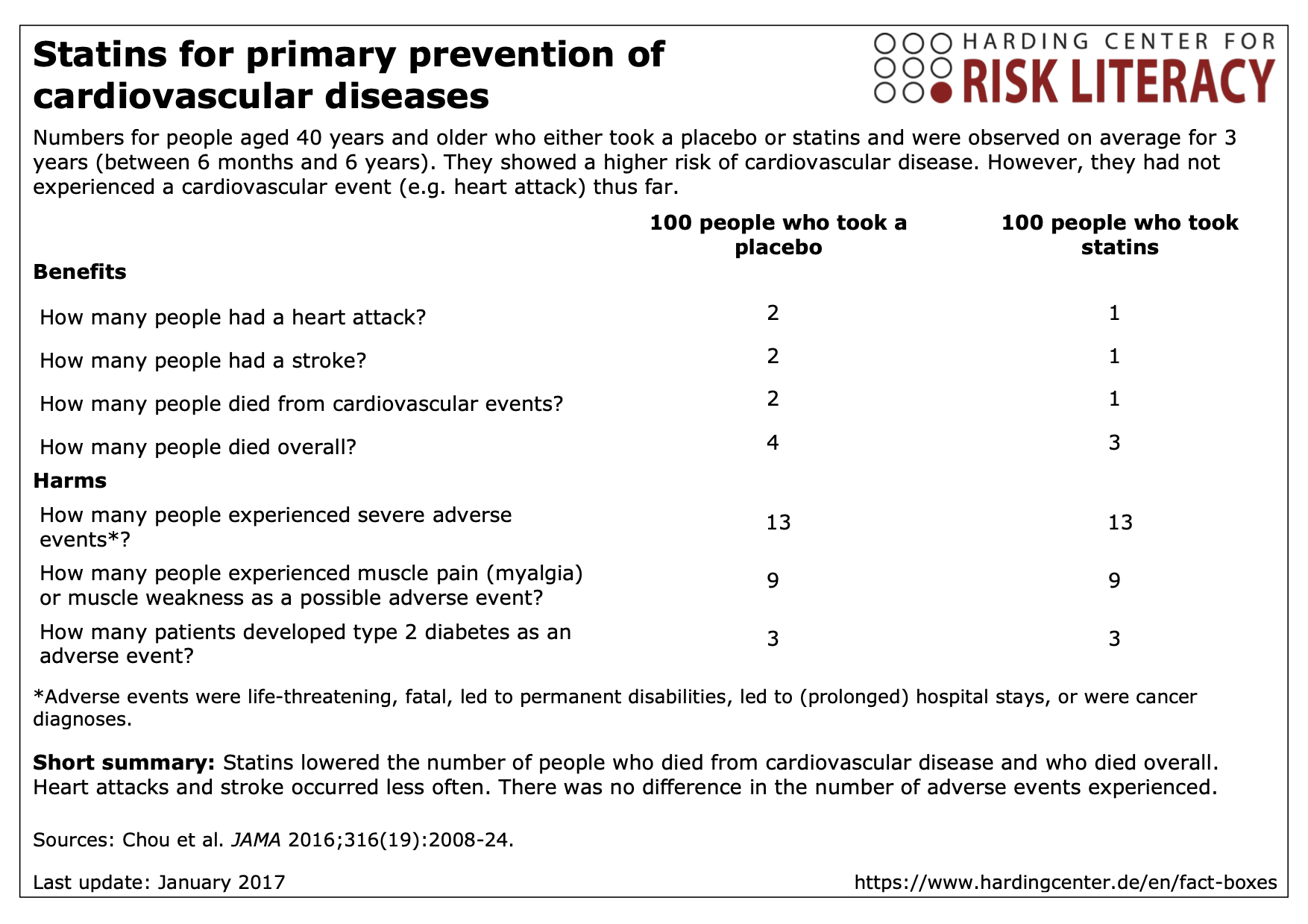This fact box will help you to weigh the benefits and harms of statins for primary prevention of cardiovascular diseases. The information and numbers are based on the best scientific evidence currently available.
This fact box was developed by the Harding Center for Risk Literacy.
Primary prevention is designed to prevent cardiovascular diseases such as coronary heart disease (CHD). It aims at reducing factors that promote the occurrence of cardiovascular diseases and events (e.g. heart attacks and strokes). These risk factors include diabetes mellitus, obesity, smoking, and high blood pressure [1].
Cholesterin (oft auch als Blutfett bezeichnet) ist wichtig für die Körperfunktionen. Es wird zur Bildung bestimmter Hormone benötigt und ist ein wesentlicher Baustein der Zellwände. Dabei unterscheidet man zwei Arten von Cholesterin [1, 2]:
- LDL-Cholesterin: „LDL“ steht für Low-Density-Lipoprotein (Lipoprotein niedriger Dichte): Ein hoher LDL-Wert ist mit einem erhöhten Risiko für Herz-Kreislauf-Erkrankungen verbunden, deshalb steht LDL für das „schlechte“ Cholesterin.
- HDL-Cholesterin: „HDL“ steht für High-Density-Lipoprotein (Lipoprotein hoher Dichte): Ein höher HDL-Wert steht für ein geringeres Risiko für Herz-Kreislauf-Erkrankungen. Deshalb wird das HDL auch als „gutes“ Cholesterin bezeichnet.
Da sich das LDL-Cholesterin durch verschiedene Prozesse an den Gefäßwänden anreichern und so ein Gerinnsel bilden kann, sind ein hoher LDL-Cholesterin- und ein niedriger HDL-Cholesterinspiegel anerkannte Risikofaktoren für Herz-Kreislauf-Erkrankungen. Der Cholesterinspiegel kann also dabei helfen, das individuelle Risiko für eine Herz-Kreislauf-Erkrankung oder einen Herz-Kreislauf-Vorfall abzuschätzen. Das bedeutet aber nicht, dass alles, was das Cholesterin senken kann oder verspricht, das zu tun, auch wirklich gut für die eigene Gesundheit ist [2].
Verschiedene lebensstilbedingte Faktoren (z.B. falsche bzw. fettreiche Ernährung, Bewegungsmangel) und Krankheiten (z.B. Schilddrüsenunterfunktion, Diabetes) können die Ursachen für einen erhöhten LDL-Cholesterinspiegel sein. Seltener sind erhöhte Cholesterinwerte auf eine genetische Veranlagung zurückzuführen [2].
Statins are among the most widely prescribed medications [2]. Whereas the use of statins for pre-existing cardiovascular diseases (secondary prevention) is widely supported, their use for primary prevention remains controversial [3].
Statins are primarly used to reduce the level of low-density lipoprotein (LDL) cholesterol in the blood. An increased LDL level is a risk factor for cardiovascular diseases because it might lead to narrowing of the arteries (atherosclerosis). Various lifestyle factors (e.g. poor or high-fat diet, lack of exercise) as well as diseases (e.g. hypothyroidism, diabetes) are regarded as causes of high cholesterol levels. Genetic predispositions to high cholesterol levels are less common. Statins are designed to prevent arteries from narrowing due to build-up of plaque and any consequent complications [1].
Seven different statins are available: atorvastatin, fluvastatin, lovastatin, pivastatin, pravastatin, rosuvastatin und simvastatin [3].
The treatment targets people with a higher risk of cardiovascular events who have not experienced any such event thus far.
Because the use of statins for primary prevention remains controversial, the priority is to reduce lifestyle risk factors [1, 3].
Before using statins, preventive measures to reduce lifestyle risk factors should be considered, such as smoking cessation, changes to diet, exercise, and weight loss. On the basis of a study from 2013, the Swiss Medical Board recommends that "prescribing of statins for primary prevention […] should only be considered if all other options for reducing risk factors are exhausted [4]."

This fact box shows the benefits and harms of statins compared to placebos for people over 40 years.
The table may be read as follows:
2 out of every 100 people, monitored 6 months to 6 years, who took a placebo had a heart attack. 1 out of every 100 people who took statins had a heart attack.
The numbers in this fact box are rounded. They are based on 19 studies with about 71,000 participants [3].
17 out of 19 studies were either partially or fully funded by pharmaceutical companies.
The studies included patients with higher risks of cardiovascular events. These risks were determined by various criteria, such as metabolic disorders, premature conditions affecting cerebral blood vessels, diabetes mellitus, and high blood pressure [3].
The authors of the study evaluated the quality of evidence as good. The studies they included met the methodological requirements. It is very unlikely that further research will change the results.
- January 2017 (last update)
Information within the fact box was obtained from the following sources:
[1] Collins R, Reith C, Emberson J, et al. Interpretation of the evidence for the efficacy and safety of statin therapy. Lancet 2016;388(10059):2532-61. doi: 10.1016/S0140-6736(16)31357-5.
[2] Grandt D, Schubert I. Arzneimittelreport. Analysen zur Arzneimitteltherapie und Arzneimittelsicherheit. In: Barmer GEK, ed. Schriftenreihe zur Gesundheitsanalyse. 39 ed. Berlin, 2016.
[3] Chou R, Dana T, Blazina I, et al. Statins for prevention of cardiovascular disease in adults: Evidence report and systematic review for the us preventive services task force. JAMA 2016;316(19):2008-24. doi: 10.1001/jama.2015.15629.
[4] Swiss Medical Board. Statine zur Primärprävention kardiovaskulärer Erkrankungen. 2013: 1-38.
Documentation on how the numbers in the fact box were determined is available on request.
